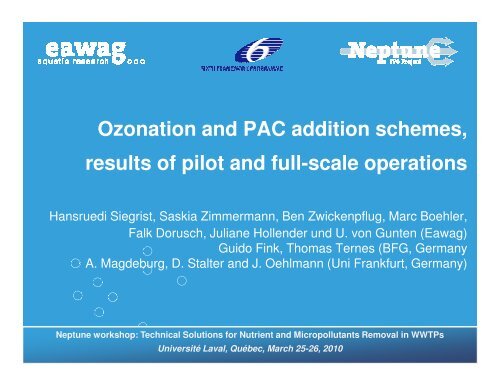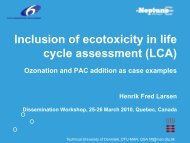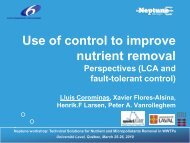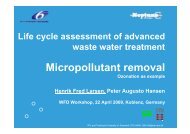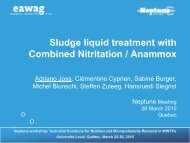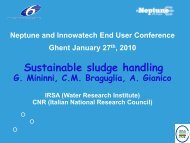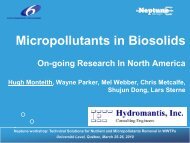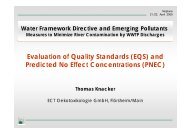Ozonation and PAC addition schemes, results - EU Project Neptune
Ozonation and PAC addition schemes, results - EU Project Neptune
Ozonation and PAC addition schemes, results - EU Project Neptune
You also want an ePaper? Increase the reach of your titles
YUMPU automatically turns print PDFs into web optimized ePapers that Google loves.
<strong>Ozonation</strong> <strong>and</strong> <strong>PAC</strong> <strong>addition</strong> <strong>schemes</strong>,<br />
<strong>results</strong> of pilot <strong>and</strong> full-scale operations<br />
Hansruedi Siegrist, Saskia Zimmermann, Ben Zwickenpflug, Marc Boehler,<br />
Falk Dorusch, Juliane Hollender und U. von Gunten (Eawag)<br />
Guido Fink, Thomas Ternes (BFG, Germany<br />
A. Magdeburg, D. Stalter <strong>and</strong> J. Oehlmann (Uni Frankfurt, Germany)<br />
<strong>Neptune</strong> workshop: Technical Solutions for Nutrient <strong>and</strong> Micropollutants Removal in WWTPs<br />
Eawag: Swiss Federal Institute of Aquatic Science <strong>and</strong> Technology<br />
Université Laval, Québec, March 25-26, 2010
Full scale ozonation at WWTP Regensdorf<br />
Primary<br />
effluent<br />
activated sludge treatment<br />
Secondary<br />
effluent<br />
<strong>Ozonation</strong><br />
effluent<br />
Upstream<br />
WWTP<br />
S<strong>and</strong>filtration<br />
sedimentation<br />
O 3<br />
Primary<br />
sedimentation<br />
S<strong>and</strong><br />
filtration<br />
effluent<br />
36 m 3 Downstream<br />
sampling points<br />
• population equivalent: 25.000<br />
• water flow under dry weather conditions:<br />
30-120 L/sec ~ 50 % water flow of creek<br />
WWTP
<strong>Ozonation</strong><br />
7<br />
1.7m3 effluent<br />
FS<br />
0<br />
1.3m 3<br />
6<br />
s<strong>and</strong> filter<br />
8<br />
V tot =36.1m 3<br />
5<br />
4.3m 3<br />
9.6m 3<br />
2.0m 3<br />
3<br />
1<br />
8.6m 3<br />
4.3m 3 6.0m 3<br />
4<br />
2<br />
<br />
0.7 m 0.6 m 0.6 m 1.0 m 0.6 m 1.0 m<br />
3.15 m<br />
width 2.55 m<br />
4.50 m
Ozone dosage<br />
Full-scale ozonation<br />
Online measurement of ozone <strong>and</strong> DOC (as UV absorption)<br />
Control of ozone concentration by DOC measurements<br />
Ozone concentration: 0 – 1200 g /kg DOC ≈ 0 – 6 mg/L Ozone<br />
Sampling<br />
10 sampling compaigns<br />
24h- or 48h-volume proportional composite samples<br />
Fitration on-site (0.7 µm glassfiber filters)<br />
Analysis<br />
Micropollutants<br />
Ecotoxicity<br />
Pathogens
Effect of ozone concentration on<br />
elimination efficiency<br />
Calculation: 100 – 100 *c after ozonation / c secondary effluent<br />
Diclofenac<br />
Trimethoprim<br />
Sulfapyridin<br />
Carbamazepin<br />
Ozone in<br />
g/kg DOC<br />
966 +/- 271<br />
617 +/- 47<br />
396 +/- 63<br />
Clarithromycin<br />
H 3 C<br />
O<br />
Sulfamethoxazol<br />
CH 3<br />
CH 3<br />
HO<br />
H 3 C<br />
O<br />
O<br />
OH<br />
CH 3<br />
O<br />
O<br />
O<br />
O<br />
HO<br />
O<br />
OH<br />
N<br />
CH 3<br />
O<br />
Metoprolol<br />
Methylbenzotriazol<br />
Benzotriazol<br />
Atenolol<br />
O<br />
Mecoprop<br />
H 2 N<br />
S<br />
O<br />
N<br />
H<br />
N<br />
O<br />
Atrazin<br />
0 20 40 60 80 100<br />
Eliminiation (%)
Elimination efficiency – micropollutants<br />
Number<br />
Secondary<br />
Effluent<br />
<strong>Ozonation</strong> effluent<br />
(634 g O3/kg DOC) ><br />
<strong>Ozonation</strong> effluent<br />
(634 g O3/kg DOC)<br />
>15 ng/L<br />
15 ng/L<br />
> 100 ng/L<br />
Pharmaceuticals 14 12 3 Atenolol<br />
Antibiotics 10 8 0<br />
X-Ray contrast media 6 6 not determined<br />
Biocides/Pesticides 12 8 3 Mecoprop<br />
Corrosion inhibitor 2 2 2 (Methyl)-Benzotriazol<br />
Endorine disruptors 4 1 1 Bisphenol A<br />
Metabolites 5 1 1
Elimination efficiency of toxic effects<br />
Testbattery (in vitro)<br />
Bioluminescence test<br />
Algae test<br />
Acetylcholinesterase test<br />
Yeast estrogen screen (YES)<br />
non-specific toxicity<br />
inhibition of photosynthesis<br />
neurotoxicity<br />
endocrine disruption<br />
HO<br />
OH<br />
H<br />
H H<br />
estrogen<br />
gene product :<br />
enzyme ß-galactosidase<br />
orange<br />
ERE<br />
reporter gene red<br />
Plasmid<br />
human estrogen receptor<br />
yeast cell
Elimination efficiency of toxic effects<br />
non-specific toxicity<br />
specific toxicity<br />
8<br />
7<br />
6<br />
72 301<br />
bioluminescence<br />
algae growth<br />
8<br />
6<br />
78<br />
DEQ (µg/L)<br />
PTEQ (µg/L)<br />
EEQ (ng/L)<br />
5<br />
4<br />
4<br />
3<br />
2<br />
2<br />
1<br />
0<br />
0<br />
<strong>Ozonation</strong> leads to a significant reduction<br />
of non-specific <strong>and</strong> specific toxicity<br />
Ozone dose<br />
600 g O 3 / kg DOC
Cancerogenic nitrosamines<br />
- byproducts of ozonation?<br />
C<br />
H 3<br />
C<br />
Mean values of 9 -11 sampling campaigns<br />
N<br />
N<br />
O<br />
Concentration (ng/L)<br />
30<br />
20<br />
10<br />
NDBA<br />
NDEA<br />
NDMA<br />
NMOR<br />
NPIP<br />
C<br />
H 3<br />
C<br />
H 3<br />
H 3<br />
C<br />
H 3<br />
C<br />
O<br />
N<br />
H 3<br />
N N<br />
O<br />
N<br />
O<br />
N N<br />
O<br />
0<br />
Primary<br />
effluent<br />
Secondary<br />
effluent<br />
<strong>Ozonation</strong><br />
effluent<br />
S<strong>and</strong> filtration<br />
effluent<br />
N<br />
N<br />
O
Bromate formation in ozone reactor<br />
740 g O3/kg DOC<br />
15.0<br />
12.5<br />
35<br />
30<br />
810 g O3/kg DOC<br />
900 g O3/kg DOC<br />
1240 g O3/kg DOC<br />
Bromate [µg/L]<br />
10.0<br />
7.5<br />
5.0<br />
2.5<br />
Drinking water st<strong>and</strong>ard for Bromate<br />
25<br />
20<br />
15<br />
10<br />
5<br />
Bromide [µg/L]<br />
0.0<br />
Reactor ZU Second P3 Reactor AB Effluent SF<br />
influent Compartment effluent s<strong>and</strong>filtration<br />
0<br />
• Bromate formation only for very high ozone dose (LOQ = 2 µg L -1 )<br />
• Concentration remains even below the drinking water st<strong>and</strong>ard!
AOC formation in the ozonation reactor<br />
assimilable organic carbon [µg L -1 ]<br />
900<br />
800<br />
700<br />
600<br />
500<br />
400<br />
300<br />
200<br />
100<br />
AOC formation for different ozone doses<br />
200 g O3/kg DOC<br />
600 g O3/kg DOC<br />
810 g O3/kg DOC<br />
900 g O3/kg DOC<br />
0<br />
Influent Reactor Point 1<br />
in Reactor<br />
Point 3<br />
in Reactor<br />
Effluent<br />
Reactor<br />
Effluent S<strong>and</strong><br />
Filtration<br />
sampling position<br />
• ozonation increases the assimilable organic carbon up to a factor of 3.5<br />
• s<strong>and</strong> filtration decreases it subsequently to twice the influent concentration
Desinfection efficiency of ozonation<br />
Intakte Zellen [Anzahl/ml]<br />
Säulen<br />
Intact cells [No/ml]<br />
1.E+07<br />
1.E+06<br />
1.E+05<br />
1.E+04<br />
1.E+03<br />
1.E+02<br />
1.E+01<br />
1.E+05<br />
1.E+04<br />
1.E+03<br />
1.E+02<br />
1.E+01<br />
200 g O3/kg DOC<br />
210 g O3/kg DOC<br />
410 g O3/kg DOC<br />
600 g O3/kg DOC<br />
740 g O3/kg DOC<br />
810 g O3/kg DOC<br />
900 g O3/kg DOC<br />
1240 g O3/kg DOC<br />
E. coli [cfu/100ml]<br />
E.coli [cfu/100ml]<br />
Punkte<br />
500 cfu E.coli/100 ml<br />
<strong>EU</strong>-Bath water<br />
directive<br />
1.E+00<br />
1.E+00<br />
Influent ZU Comp.1 P1 Comp. P3 2 Effluent AB Effluent SF<br />
<strong>Ozonation</strong> S<strong>and</strong>filter
Electrical energy for ozon from air oxygen<br />
Energy consumption (15m 3 process gas h -1 )<br />
Energy consumption [kWh kg<br />
-1 O3]<br />
35<br />
30<br />
25<br />
20<br />
15<br />
10<br />
5<br />
Total: O 3 process + O 2 production + transport<br />
O 3 process: Container + online probes + computers<br />
Container: O 3 production + thermal ozone distructor + cooling aggregate<br />
O 3 production: dielectric barrier discharge, control system<br />
0<br />
30 50 70 90 110 130 150 170<br />
Process gas concentration [gO 3 m -3 process gas]
Short-circuiting in ozonation reactor<br />
14<br />
Three-dimensional CFD-simulation for Q = 0.15 m 3 sec -1 , <strong>and</strong> O 3 -dosage = 5 g m -3<br />
Markus Gresch, Process Engineering, Eawag
Behavior during stormwater<br />
2007-12-06 08:00:00 bis 2007-12-07 08:00:00<br />
Q [l/s]<br />
300<br />
250<br />
200<br />
150<br />
100<br />
Q Zulauf Reaktor (14079m^3)<br />
DOC Zulauf Reakor (4.7mg/L)<br />
O3 gelöst Ablauf K2 (0.1mg/l)<br />
O3 gelöst Ablauf K6 (0mg/l)<br />
7h<br />
8<br />
7<br />
6<br />
5<br />
4<br />
DOC [mg/l]<br />
2<br />
1.8<br />
1.6<br />
1.4<br />
1.2<br />
1<br />
0.8<br />
0.6<br />
O3 gelöst K2+6[mg/l]<br />
50<br />
3<br />
0 2<br />
0.4<br />
0.2<br />
0<br />
Dosis DOC [gO3/kgDOC]<br />
1000<br />
800<br />
600<br />
400<br />
200<br />
Solldosis DOC (600 gO3/kgDOC)<br />
Solldosis minus Eintragseinbusse (588 gO3/kgDOC)<br />
Aus Daten berechnete effektive Dosis DOC (357 gO3/kgDOC)<br />
Resultierende effektive Dosis Rohw asser (1.59 mg/L)<br />
10<br />
8<br />
6<br />
4<br />
2<br />
Dosis Rohw. [mgO3/l]<br />
0<br />
0<br />
2007-12-06 08:00:00 2007-12-07 08:00:00<br />
15<br />
8:00 10:00 12:00 14:00 16:00 18:00 20:00 22:00 24:00 2:00 4:00 6:00 8:00
Conclusions <strong>Ozonation</strong><br />
Full scale reactor in Regensdorf proves ozonation to be an efficient<br />
technique for the elimination of micropollutants <strong>and</strong> disinfection<br />
0.6-0.8 g Ozone/g DOC is sufficient to significantly reduce (80-100%)<br />
the selected micropollutants<br />
<strong>Ozonation</strong> reduces both specific <strong>and</strong> non-specific in vitro ecotoxicity<br />
S<strong>and</strong>filtration seems appropriate as an <strong>addition</strong>al barrier for the elimination<br />
of products formed during ozonation e.g. NDMA but especially AOC<br />
Bromate formation is not of concern in wastewater with such low<br />
bromide concentrations<br />
E.coli is reduced significantly <strong>and</strong> bathing water quality reached with 0.6<br />
g O3 /g DOC , 0.9 g O3 /g DOC reaches the requested CT-value of 10 min⋅mg O3 /l<br />
HRT should be 15-20 minutes during dry weather to prevent ozone loss<br />
during stormwater (HRT about 5 minutes)<br />
Short circuiting in the ozonation chamber should be avoided<br />
Energy consumption for 1 kg ozone incl. pure oxygen production <strong>and</strong><br />
transport to WWTP is about 15-17 kWh<br />
For 0.8 gO 3 /gDOC <strong>and</strong> 5-10 gDOC m -3 wastewater electrical energy<br />
consumption 16 is 0.06 - 0.13 kWh m -3 (20-40% of nutrient removal WWTP
<strong>PAC</strong> <strong>addition</strong> - Overview<br />
• Introduction: potential flow <strong>schemes</strong><br />
• Effect of Background DOC on <strong>PAC</strong> dosage<br />
• <strong>PAC</strong>-Application: Pilot- <strong>and</strong> full scale experiments<br />
• Contact SBR: Single- <strong>and</strong> two stage application<br />
• Flocculation/s<strong>and</strong>filtration: Single stage application<br />
• Modelling <strong>PAC</strong> <strong>addition</strong> with <strong>and</strong> without <strong>PAC</strong> recycling<br />
• Conclusions
Introduction – potential flow <strong>schemes</strong><br />
<strong>PAC</strong>/flocculant <strong>addition</strong> to a contact/flocculation tank with <strong>addition</strong>al<br />
sedimentation or membrane separation for <strong>PAC</strong> recycling<br />
After the sedimentation a filter is needed to reduce <strong>PAC</strong> loss<br />
<strong>PAC</strong><br />
Al or Fe<br />
Sedimentation followed<br />
by filtration or<br />
membrane separation<br />
Alternatives:<br />
• <strong>PAC</strong> <strong>addition</strong> to filtration<br />
• <strong>PAC</strong> additon directly to activated sludge system<br />
Al or Fe<br />
<strong>PAC</strong><br />
Al or Fe<br />
<strong>PAC</strong>
Effect of background DOC<br />
Iopamidol<br />
100<br />
80<br />
10 mg <strong>PAC</strong>/l<br />
20 mg <strong>PAC</strong>/l<br />
Elimination [%]<br />
60<br />
40<br />
20<br />
Sulfamethoxazole<br />
0<br />
100<br />
80<br />
0 2 4 6 8 10 12<br />
DOC [mg/l]<br />
10 mg<strong>PAC</strong>/l<br />
20 mg<strong>PAC</strong>/<br />
Elimination [%]<br />
60<br />
40<br />
20<br />
0<br />
0 2 4 6 8 10 12<br />
DOC [mg/l]
<strong>PAC</strong> <strong>addition</strong> to secondary effluent<br />
(SBR, with <strong>and</strong> without <strong>PAC</strong> recycling)<br />
Pilot plant Eawag<br />
SRT ~ 13 d SRT ~ 15 d<br />
<strong>PAC</strong><br />
+Fe(III)<br />
SRT ~ 4 d<br />
Lane A<br />
Denitrification<br />
Nitrification<br />
Secondary clarifier<br />
Storage Buffer tank 11 Ads-SBR Storage Buffer tank 2<br />
Cloth filter<br />
Flow<br />
direction<br />
Effluent<br />
Influent<br />
(mechanical pretreated<br />
wastewater)<br />
Return sludge<br />
Flushing water (optional)<br />
Flushing water<br />
<strong>PAC</strong> excess sludge (optional)<br />
<strong>PAC</strong> excess sludge<br />
Excess<br />
sludge<br />
<strong>PAC</strong> excess<br />
sludge<br />
Flushing water<br />
Nitrification<br />
Lane B<br />
SRT ~ 13 d<br />
Denitrification Nitrification<br />
<strong>PAC</strong>-<br />
Suspension<br />
Secondary<br />
Clarifier<br />
Secondary clarifier<br />
Cloth Filter<br />
<strong>PAC</strong>-SBR<br />
Effluent<br />
Denitrification<br />
Return sludge<br />
Excess<br />
sludge<br />
Storage Tank<br />
sampling point<br />
Storage Tank
<strong>PAC</strong> <strong>addition</strong> to secondary effluent (SBR)<br />
Pilot plant Eawag<br />
100%<br />
10 mg<strong>PAC</strong>/l without <strong>PAC</strong>-recycling to biology (Pilot: 8.8 mgDOC/l; ref: 8.4 mgDOC/l)<br />
10 mg<strong>PAC</strong>/l with <strong>PAC</strong>-recycling to biology (Pilot: 7.4 mgDOC/l; ref: 8.9 mgDOC/l)<br />
15 mg<strong>PAC</strong>/l with <strong>PAC</strong>-recycling to biology (Pilot: 5.5 mgDOC/l; ref: 6.7 mgDOC/l)<br />
80%<br />
60%<br />
40%<br />
<strong>PAC</strong> recycling into the biology (counter<br />
flow) improves efficiency<br />
Elimination<br />
20%<br />
0%<br />
Atenolol Atenolol<br />
Benzotriazol<br />
Benzotriazol<br />
Sulfamethoxazol<br />
Sulfamethoxazol<br />
Bezafibrat Bezafibrat<br />
Naproxen Naproxen<br />
Ibuprofen Ibuprofen<br />
Iohexol Iohexol<br />
Iopromid Iopromid<br />
Oxazepam Oxazepam<br />
Codein Codein<br />
Primidon Primidon<br />
DHH DHH<br />
Venlafaxin Venlafaxin<br />
Ranitidin Ranitidin<br />
5-Methyl-Benzotriazol<br />
5-Methyl-Benzotriazol<br />
Mefenaminsäure<br />
Mefenaminsäure<br />
Clarithromyzin<br />
Clarithromyzin<br />
Carbamazepin<br />
Carbamazepin<br />
Diclofenac Diclofenac<br />
All elimination rates referring to primary effluent
<strong>PAC</strong> <strong>addition</strong> to secondary effluent (SBR)<br />
Effluent primary clarifier (3.measuring campaign) Effluent reference (3. measuring campaign)<br />
100000<br />
Effluent Pilot, 15 mg<strong>PAC</strong> with recycling Effluent contact reactor, 15mg<strong>PAC</strong>/l with recycl.<br />
DOC: Reference 6.7 mg/l, Pilot: 5.5mg/l, contact reactor: 3.4mg/l<br />
10000<br />
1000<br />
100<br />
10<br />
mean concentration [ng/l]<br />
1<br />
Atenolol<br />
Benzotriazol<br />
Sulfamethoxazol<br />
Iohexol<br />
Iopromid<br />
Bezafibrat<br />
Naproxen<br />
Ibuprofen<br />
Oxazepam<br />
Codein<br />
Primidon<br />
DHH<br />
Venlafaxin<br />
Ranitidin<br />
5-Methyl-Benzotriazol<br />
Mefenaminsäure<br />
Clarithromyzin<br />
Carbamazepin<br />
Diclophenac<br />
Concentrations of micropullants
Impossible<br />
d'afficher l'image.<br />
Votre ordinateur<br />
manque peut-être<br />
de mémoire pour<br />
ouvrir l'image ou<br />
l'image est<br />
endommagée.<br />
Redémarrez<br />
l'ordinateur, puis<br />
ouvrez à nouveau<br />
le fichier. Si le x<br />
Impossible d'afficher l'image.<br />
Votre ordinateur manque<br />
peut-être de mémoire pour …<br />
Impossible d'afficher l'image.<br />
Votre ordinateur manque<br />
peut-être de mémoire pour<br />
ouvrir l'image ou l'image est<br />
endommagée. Redémarrez<br />
l'ordinateur, puis ouvrez à<br />
nouveau le fichier. Si le x<br />
rouge est toujours affiché,<br />
vous devrez peut-être<br />
supprimer l'image avant de<br />
la réinsérer.<br />
Impossible d'afficher l'image. Votre ordinateur manque peutêtre<br />
de mémoire pour ouvrir l'image ou l'image est<br />
endommagée. Redémarrez l'ordinateur, puis ouvrez à<br />
nouveau le fichier. Si le x rouge est toujours affiché, vous<br />
devrez peut-être supprimer l'image avant de la réinsérer.<br />
Impossible d'afficher l'image. Votre ordinateur manque peutêtre<br />
de mémoire pour ouvrir l'image ou l'image est<br />
endommagée. Redémarrez l'ordinateur, puis ouvrez à nouveau<br />
le fichier. Si le x rouge est toujours affiché, vous devrez peutêtre<br />
supprimer l'image avant de la réinsérer.<br />
Impossible d'afficher l'image. Votre ordinateur manque peutêtre<br />
de mémoire pour ouvrir l'image ou l'image est<br />
endommagée. Redémarrez l'ordinateur, puis ouvrez à nouveau<br />
le fichier. Si le x rouge est toujours affiché, vous devrez peutêtre<br />
supprimer l'image avant de la réinsérer.<br />
<strong>PAC</strong> <strong>addition</strong> to s<strong>and</strong> filtration (single stage)<br />
Turbulence tank<br />
Pilot plant Eawag<br />
4.5 m<br />
Spill over<br />
Fe 3+<br />
Secondary<br />
clarifier effluent<br />
<strong>PAC</strong><br />
HRT 30 – 80min<br />
Filtration<br />
rate 4.5 –<br />
12.5 m/h<br />
SRT <strong>PAC</strong> = 12 h<br />
Effluent<br />
Water head<br />
0.5 – 1 m<br />
Backwash<br />
water<br />
Pressure head<br />
+ 0.5 mbar<br />
Exp<strong>and</strong>ed slate<br />
(120cm)<br />
Backflush interval 1 d<br />
Silica s<strong>and</strong><br />
(40cm)<br />
Water + compressed air for<br />
flushing (1x/d)<br />
Flushing<br />
nozzles<br />
Outlet
<strong>PAC</strong> <strong>addition</strong> to s<strong>and</strong> filtration<br />
Pilot plant Eawag<br />
Behä lter 3 u. 4<br />
Flocculation tanks<br />
Spillover<br />
Influent Zulauf<br />
Back flush by<br />
air <strong>and</strong> process<br />
water<br />
black colored water is<br />
flushed out by clean<br />
backwash water<br />
Exp<strong>and</strong>ed schiefer slade<br />
Silicia Quarz s<strong>and</strong><br />
Outlet
Full-scale experiments at WWTP Opfikon<br />
Activated sludge system with two lanes for nitrification <strong>and</strong> denitrification for<br />
60‘000 PE, each lane has two biology tanks with two secondary clarifiers<br />
Each lane has one flocculation reactor followed by four two layer filters<br />
Fe <strong>and</strong> <strong>PAC</strong> were only added to the flocculation tank (HRT = 0.9 h) of<br />
lane south with one filter in operation (hydraulic load 4.3 m/h, SRT of <strong>PAC</strong><br />
in the Filter was 12 hours, backflush intervall 1x/d)<br />
Filtration
<strong>PAC</strong> <strong>addition</strong> to s<strong>and</strong> filtration<br />
100%<br />
S<strong>and</strong>filter Kloten/Opfikon (15mg<strong>PAC</strong>/l; DOC: effluent biology: 4 - 6mgDOC/l)<br />
S<strong>and</strong>filter Experimental Hall (15mg<strong>PAC</strong>/l DOC: effluent biology: 6.4mg/l; effluent s<strong>and</strong>filter: 4mg/l)<br />
80%<br />
60%<br />
40%<br />
20%<br />
High potential of <strong>PAC</strong> <strong>addition</strong> to s<strong>and</strong>filtration<br />
If <strong>PAC</strong> loss to the effluent can be prevented<br />
Elimination efficiency<br />
Full scale 2008, filtration rate 4.5m/h: TSS loss up to 9 mg/l<br />
0%<br />
Pilot Eawag 2009, filtration rate 6.5 m/h: TSS loss 2-3 mg/l<br />
All trials without <strong>PAC</strong> recycling via back flush water into biology<br />
N-AC-Sulfamethoxa.<br />
N-AC-Sulfamethoxa.<br />
Atenololsäure<br />
Atenololsäure<br />
Metroprolol Metroprolol<br />
Venlafaxin Venlafaxin<br />
Ranitidin Ranitidin<br />
5-Methyl-Benzotriazol<br />
5-Methyl-Benzotriazol<br />
Mefenaminsäure<br />
Mefenaminsäure<br />
Atenolol Atenolol<br />
Terbutryn Terbutryn<br />
Carbendazim<br />
Carbendazim<br />
Triclosan Triclosan<br />
Codein Codein<br />
Ibuprofen Ibuprofen<br />
Iohexol Iohexol<br />
Iopromid Iopromid<br />
Fenoprofen Fenoprofen<br />
Bezafibrat Bezafibrat<br />
Naproxen Naproxen<br />
Diclofenac Diclofenac<br />
BTSA BTSA<br />
Mecoprop Mecoprop<br />
Diuron Diuron<br />
Tramadol Tramadol<br />
Benzoylegconine<br />
Benzoylegconine<br />
Carbamazepin<br />
Carbamazepin<br />
Methadon Methadon<br />
Oxazepam Oxazepam<br />
Primidon Primidon<br />
Dihy.-dihy.-carbama.<br />
Dihy.-dihy.-carbama.<br />
Benzotriazole<br />
Benzotriazole<br />
Carbamazepin<br />
Carbamazepin<br />
Sulfamethoxazol<br />
Sulfamethoxazol<br />
Clarithromycin<br />
Clarithromycin<br />
SRT <strong>PAC</strong> = 12h<br />
All Elimination rates referring to secondary effluent
Elimination of background DOC<br />
Dosage Treatment System<br />
effluent secondary<br />
clarifier<br />
Reference Pilot<br />
effluent<br />
contact reactor /<br />
s<strong>and</strong>filter<br />
Elimination<br />
efficiency<br />
mg<strong>PAC</strong> l-1 mgDOC l-1<br />
%<br />
10 single stage SBR without recycle 8.4 8.8 7.5 14.8 15<br />
10 two stage SBR with recycle 8.9 7.4 5.5 25.7 38<br />
15 two stage SBR with recycle 6.6 5.5 3.4 38.2 48<br />
15 single stage S<strong>and</strong>filtration pilot 6.4 4 37.5
<strong>PAC</strong> <strong>addition</strong> to activated sludge system<br />
100<br />
Reference 20 mg<strong>PAC</strong>/l 40 mg<strong>PAC</strong>/l 80 mg<strong>PAC</strong>/l<br />
80<br />
60<br />
40<br />
Elimination [%]<br />
20<br />
0<br />
DHC<br />
Carbamazepine<br />
Methadon<br />
Oxazepam<br />
Codein<br />
Dihydrocodein<br />
Temazepam<br />
Primidon<br />
DHH<br />
Bezafibrat<br />
Naproxen<br />
Clofibrinsäure<br />
Diclofenac<br />
Ibuprofen<br />
Roxithromycin<br />
N-AC-Sulfamethox.<br />
Sulfamethoxazole<br />
Erythromycin<br />
Clarithromycin<br />
Diatrizoat<br />
Iohexol<br />
Iopromid<br />
Iomeprol<br />
Iopamidol<br />
All Elimination rates referring to primary effluent
In-vivo Tests in a flow-through system<br />
Organism Endpoints OZ SF AC<br />
Chironomus<br />
riparius<br />
Lumbriculus<br />
variegatus<br />
Potamopyrgus<br />
antipodarum<br />
Dreissena<br />
polymorpha<br />
Daphnia magna<br />
Oncorhynchus<br />
mykiss (FELST)<br />
Lemna minor<br />
Mortality<br />
Emergence time<br />
Reproduction<br />
Biomass<br />
Reproduction<br />
DNA damage<br />
Reproduction<br />
Mortality<br />
Development<br />
Biomass<br />
Vitellogenin<br />
Frond area<br />
Biomass<br />
Significant effects compared to sec. effluent: negative; positive; no effect<br />
29
Energy <strong>and</strong> cost for Ozon <strong>and</strong> <strong>PAC</strong><br />
Treatment<br />
Dosage<br />
[mg L -1 ]<br />
Electrical<br />
energy<br />
[kWh m -3 ww]<br />
Primary<br />
energy<br />
[kWh m -3 ww]<br />
Annual Costs c<br />
30'000 p.e.<br />
[€ m -3 ww]<br />
500'000 p.e.<br />
[€ m -3 ww]<br />
O 3 3 a - 10 0.05 b - 0.15 0.15 - 0.45 0.07 d - 0.1 0.02 d - 0.03<br />
O 3 incl. s<strong>and</strong><br />
filter<br />
3 a - 10 0.1 - 0.2 e 0.3 - 0.6 0.15 d - 0.2 0.05 d - 0.07<br />
<strong>PAC</strong> 10 - 20 0.005 f 0.35 - 0.7 g 0.15 - 0.2 0.06 - 0.08<br />
<strong>PAC</strong> incl.<br />
s<strong>and</strong> filter<br />
10 - 20 0.05 e,f 0.5 - 0.8 g 0.25 - 0.3 0.09 - 0.11<br />
a<br />
Ø Operating conditions @ WWTP Regensdorf (5mg DOC L -1 ≅ 600g O 3 kg -1 DOC)<br />
b<br />
Measured @ WWTP Regensdorf (production of O 3 (incl. O 2 ), thermal residual-O 3 destructor,<br />
control system, cooling aggregate ≅ 15kWh kg -1 O 3 )<br />
c<br />
Detailed, realistic cost study by Hunziker Ltd. (~300L c -1 d -1 ⇒ 100m 3 c -1 y -1 )<br />
d<br />
extrapolated from O 3 5-10mg L -1<br />
e<br />
S<strong>and</strong> filter (experience from conventional treatment)<br />
f<br />
Mixing (experience from conventional treatment)<br />
g<br />
Primary energy consumption of <strong>PAC</strong> (no regeneration) 3.5 kg carbon needed for 1 kg<strong>PAC</strong>:<br />
3.5kgC/kg<strong>PAC</strong> x 2.6kgCOD/kgC x 14MJ/kgCOD / 3.6MJ/kWh = 35kWh/kg<strong>PAC</strong>
Conclusions for <strong>PAC</strong> <strong>addition</strong><br />
Sorption efficiency of <strong>PAC</strong> reduced with increasing DOC<br />
Adequate treatment of sec. effluent requires 10 - 20 g<strong>PAC</strong>/m 3 depending<br />
on DOC background concentration (5 – 10 gDOC/m 3 )<br />
<strong>PAC</strong> dosage <strong>results</strong> in an increase of sludge production of<br />
approximately 5-10% (10-20 g<strong>PAC</strong>/m 3 )<br />
Due to the low sorption kinetics <strong>PAC</strong> sludge age in the sludge treatment<br />
system should be above 1 day, this requires a system with <strong>PAC</strong><br />
retention (e.g. filter, sedimentation or membrane)<br />
<strong>PAC</strong> recycling into the biology clearly increases elimination<br />
efficiency due to counter flow (conc. step <strong>and</strong> DOC pre-sorption)<br />
The embryo test with rainbow trouts shows a considerable<br />
developmental retardation after ozonation but not after filtration<br />
(formation of by-products that are again degraded in filtration?)<br />
Primary energy consumption is higher for <strong>PAC</strong> than ozon, but electrical<br />
energy for ozonation increases consumption of WWTP about 20-40%<br />
Investment <strong>and</strong> operation costs incl. filtration amount to 0.05-0.2 € m -3<br />
for ozonation <strong>and</strong> 0.1-0.3 € m -3 for <strong>PAC</strong> (5-30€/p/y for 100m 3 /p/y)
Thank you for your attention<br />
Acknowledgement:<br />
BAFU, Switzerl<strong>and</strong><br />
AWEL, Zürich<br />
WEDECO, WABAG, BMG Engineering<br />
Staff of WWTP Regensdorf <strong>and</strong> Opfikon<br />
This study was part of the <strong>EU</strong> <strong>Neptune</strong> project (Contract No<br />
036845, SUSTDEV-2005-3.II.3.2), which was financially<br />
supported by grants obtained from the <strong>EU</strong> Commission within<br />
the Energy, Global Change <strong>and</strong> Ecosystems Program of the<br />
32 Sixth Framework (FP6-2005-Global-4)


